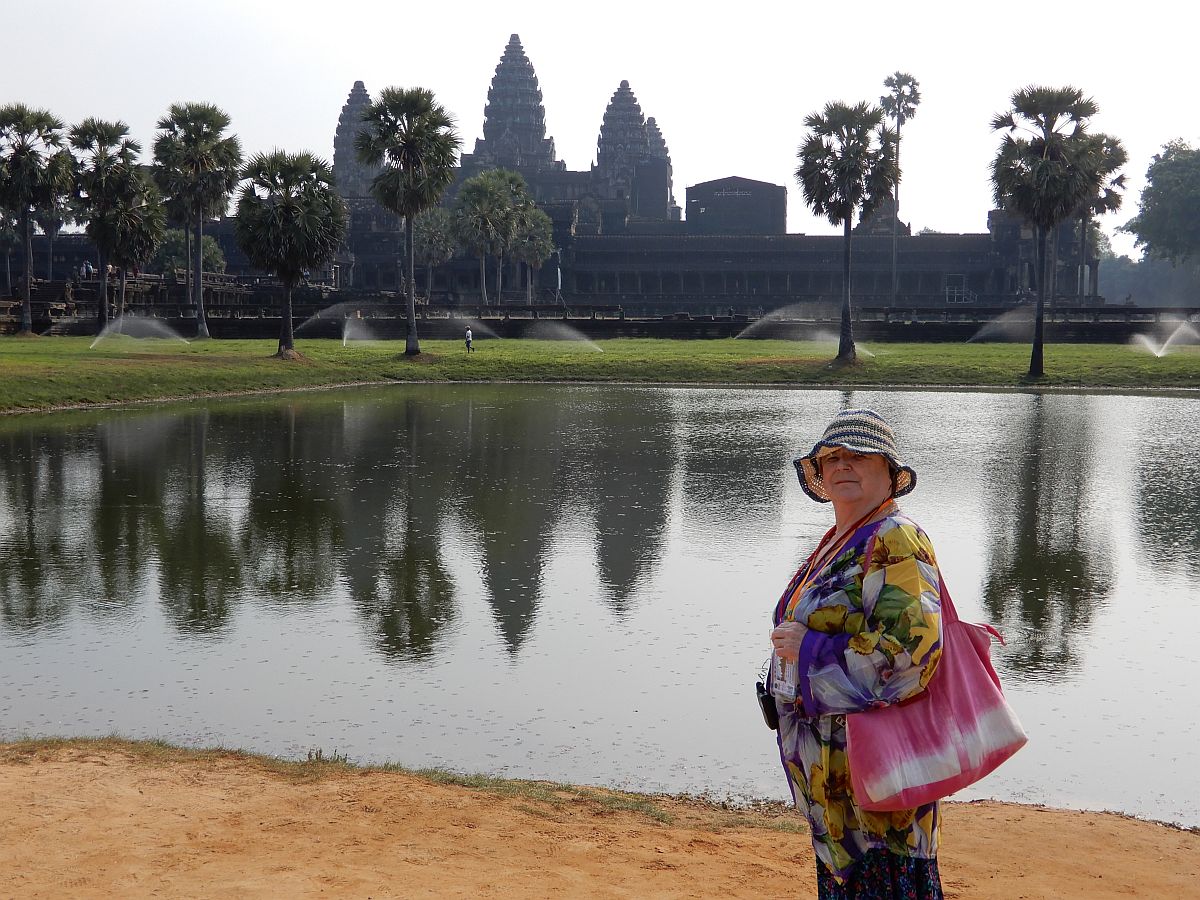
In the 12th century the capital city of the Cambodian empire was Angkor. To give some perspective, at that time the population of London was about 18,000 and that of Angkor was nearly a million. The city even reminded me of our home of Milton Keynes in that it was meticulously planned before its construction, with a grid of roads across the whole city, and a large shopping centre (as a market), and artificial lakes to collect rainwater and prevent flooding, and a central hospital to provide free treatment to citizens together with training for doctors who would serve in similar hospitals throughout the land as an early version of our own NHS, and with good transport links to the rest of the country including canals to the mountain area where the building stone was to be quarried. The religious needs of this huge city were served by the Hindu-Buddhist temple of Angkor Wat (the word Wat is Cambodian for temple) which occupied a site of almost 400 acres in the centre of the city and is now almost the only building remaining from the city which was abandoned in the 15th century and was then swallowed by the jungle.
Picture taken from Channel 4 documentary 'The lost temples of Cambodia'
Bringing the quarried stone for the construction of Angkor Wat by canal, on rafts hauled by elephants
The temple is certainly impressive; being absolutely beautiful with a wonderfully peaceful air of serenity. I took a great many photos there, but they would mean little without a detailed description to explain each of them - and this would make the page extremely long and tedious - so I have included just a few here, and put them together with a few more on the 'collections' page.
After our 3-mile long walk around the temple in 35 degree heat, including climbing the many steps to the top, we were quite exhausted and very happy to return to the hotel for a poolside lunch and an afternoon swimming in their fantastic swimming pool.
The following day the coach took us deep into the jungle to visit two smaller temple sites, those of Angkor Thom (including the Bayon Temple and the Terraces of the Leper King and of the Elephants,) and Ta Prohm (best known now for the fact that "Lara Croft: Tomb Raider" was filmed there). These are still very much over-run by the jungle, but their former beauty is very much in evidence. Again, there are further photos of all these on the 'collections' page.
Close to the Bayon Temple are the terraces of the Leper King and the Elephants. Not a great deal is known about these impressive ancient monuments, although it is almost certain that the description refers to the state of decay of the statues rather than to any disease of their royal subject.
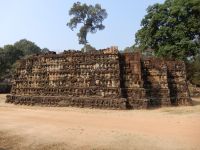 |
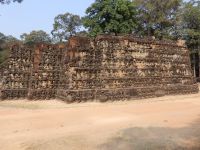 |
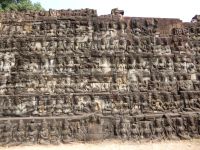 |
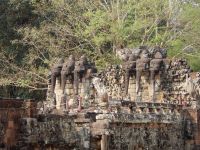 |
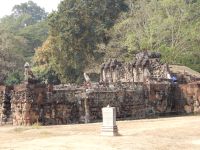 |
The Terrace of the Leper King |
The Terrace of the Elephants |
|||
Boarding the coach again, we continued through the jungle to the Temple of Ta Prohm. Still very much buried beneath the trees of the jungle, this ruined Temple was clearly very beautiful in its heyday. At the moment, however, Cambodia is very much using its connection to the Tomb Raider film as a major booster for its tourist industry.
Once again, after a busy morning in the high temperatures and humidity of the Cambodian jungle, we were happy to spend an afternoon at the hotel swimming pool, with a poolside lunch and drinks at their swim-up bar, followed by a delicious meal at a local restaurant and drinks at the hotel's Champagne bar. Then the following morning we had a leisurely departure from Siem Reap for the coach to take us on the 5 hour journey to Kampong Cham where we joined our ship, the Vikiing Saigon. On the coach trip we were kept both entertained and informed by our brilliant program director, Chung Nguyen (who described the bumpy road as a 'free bum-massage' and when the coach's air conditioning broke down he told us it was a 'free steam-sauna') and by a Cambodian guide who joined us for the journey. She told us a great deal about Cambodian life, including how Cambodians may live in relative poverty and yet at the same they revere their ancestors enough to spend a fortune on magnificent tombs for them, and spend an even greater fortune on wedding celebrations which typically have 2 to 3 thousand guests!
The ship stayed docked that day and the following day, so that we could explore around Kampong Cham. There are two Holy Mountains here, Phnom Pros (Man Hill) and Phnom Srey (Woman Hill). The ancient legend is that men and women competed to build the highest mountain in one day; with the winners having the right to make marriage proposals; the finishing time would be marked by the rising of the star Sirius (due at about 4am).The men were winning but when the women hoisted a lantern the men assumed it to be the rising star and so ceased their works. The women continued building and so won the competition (cheats!!).
On Phnom Srey there are several beautiful temple buildings, including especially the library, but the site is most famed for its gardens which have now become a memorial to those lost in the Killing Fields during the era of Khmer Rouge. Beautiful tombs and other memorials fill the gardens, together with a series of tableaux relating the life history of Buddha. Again, there are many more photos in the 'collections' page.
There are also many monkeys there, who will gleefully snatch any goods which are not carefully guarded. One monkey, for example, snatched a drinking water bottle from a lady's hand, and showed that he was well practised at this by knowing how to open the cap and take a drink from it!
At Phnom Srey we had learned a little about the genocide of the 1970s, in which nearly 2 million Cambodians (about 25% of the population) had been executed by the Khmer Rouge troops. Now however we were to have a more sobering lesson about the scale of this atrocity by visiting two memorials from that time.
The first memorial had originally been a high school in the centre of Phnom Penh before it was converted to a detention centre. Inmates of this centre, most of them being chosen from the better-educated classes who might present more of a challenge to the new regime, were tortured until they confessed to being operatives of the CIA (an organisation which they had mostly never heard of) following which they were executed as traitors, often being beheaded because they "had an American head on a Cambodian body". The site has been preserved as a starkly-presented museum.
The second and better-known memorial was at the 'Killing Fields' where thousands of executions took place, with the bodies being simply buried in mass graves. The site has been turned into a beautiful garden of remembrance, presenting a peaceful memorial but without lessening the vision of the awful scene. The whole day was quite emotional; and it is awful to contemplate the scale of the atrocities that were committed, but these two memorials are a highly fitting tribute to the individuals who suffered and died.
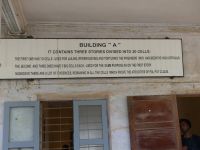 |
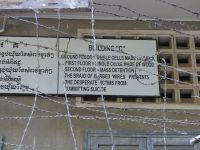 |
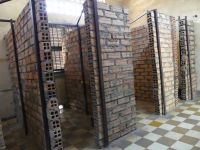 |
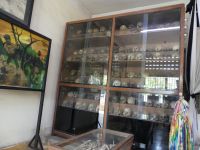 |
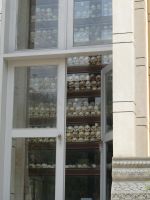 |
At the school, these two signs explain the layout |
Individual cells in Block C |
In the museum at the school |
Skulls in the Killing Fields monument |
|
After the thought-provoking day in Phnom Penh, it was a lovely contrast to visit the Udon monastery, one of Cambodia's main Buddhist sites.. It was wonderful to sit for a quarter of an hour while the monks chanted blessings to us and showered us with flower petals. Note: there are a few more images on the 'collections' page.
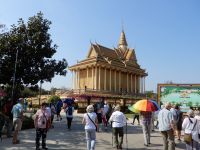 |
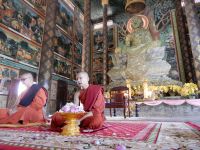 |
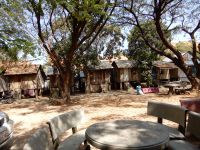 |
 |
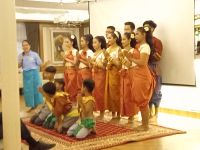 |
The buildings at the Udon Monastery were very beautiful |
We received a blessing from the monks PLAY VIDEO |
The monks lived in very simple accommodation |
The monks had long queues for their communal meals |
A group of orphan children came on board to sing and dance for us PLAY VIDEO |
Finally feeling quite worn out by our visits to these amazing temples and memorials, both ancient and modern, we returned to the ship to set sail down the River Mekong and see some aspects of modern Cambodian life. As a send-off on our voyage, a group of children from the orphanage came on board to sing to us; they were extremely talented and were a great joy to listen to.
| FlickR album of these photos | Down the Makong | A page of Temple photos | ||
| Go to Allan's Page | Our Home Page | Holidays Home Page | British Canals Page | Go to Deb's Page |
All pictures on this site are © Allan Jones unless otherwise stated